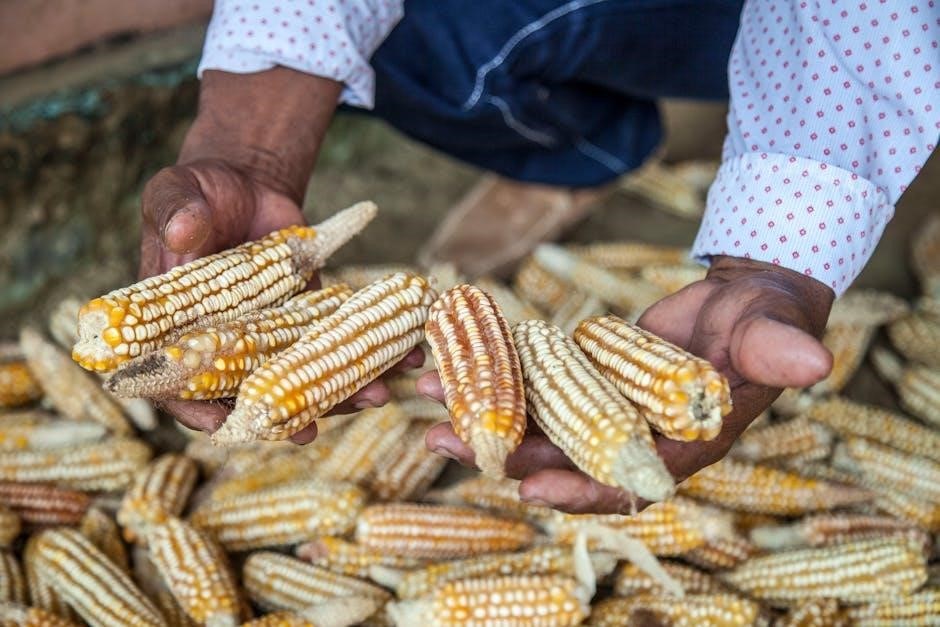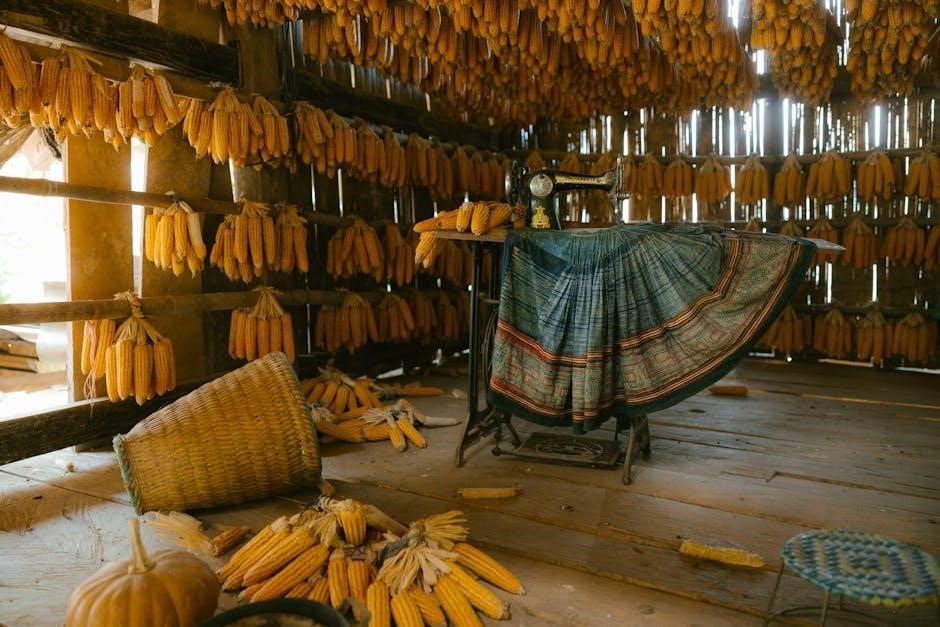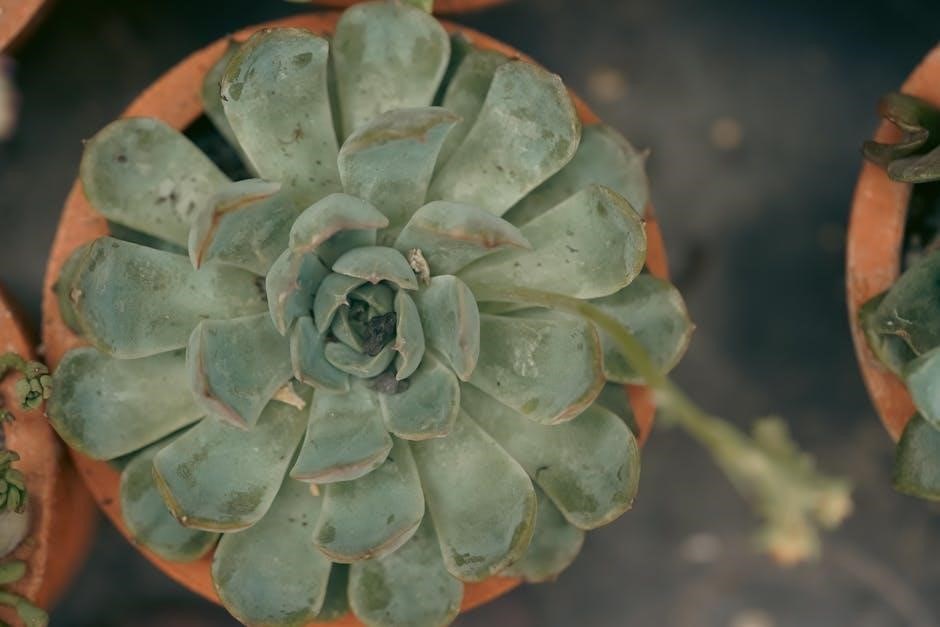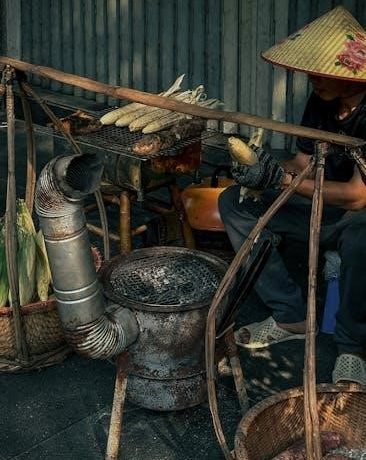The John Deere 7000 Corn Planter is a versatile and efficient planting solution designed for accurate seed placement and high productivity. Supported by a comprehensive manual, it offers detailed guidance on operation, maintenance, and troubleshooting, ensuring optimal performance for corn and other crops. With its durable design and modular setup, this planter has become a trusted choice for farmers seeking reliability and precision in their planting operations.
Overview of the John Deere 7000 Corn Planter
The John Deere 7000 Corn Planter is a reliable and efficient agricultural machine designed for precise seed placement and high productivity. As part of the MaxEmerge series, it offers modular design, durability, and versatility for various farming operations. Suitable for planting corn, soybeans, and other crops, it is available in multiple row configurations, catering to different farm sizes and needs. The planter’s robust construction and innovative features ensure accurate seed spacing and depth control, making it a popular choice among farmers. Its compatibility with modern farming practices and optional upgrades further enhances its performance, providing a cost-effective solution for achieving optimal yields and reducing waste.
Key Features and Benefits
The John Deere 7000 Corn Planter is equipped with cutting-edge features that enhance planting efficiency and accuracy. Its robust design ensures durability, while modular components allow for easy customization and maintenance. The planter features a MaxEmerge seed meter, which handles various seed sizes without additional parts, ensuring consistent seed placement. The adjustable row units enable precise seed depth and spacing control, maximizing yield potential. Additionally, the planter supports multiple row configurations, making it adaptable to different farming needs. These features, combined with its user-friendly operation and compatibility with modern farming technologies, make the John Deere 7000 a valuable asset for farmers aiming to optimize their planting operations and achieve higher yields with minimal waste.
History and Evolution of the 7000 Series
The John Deere 7000 Corn Planter, introduced in the mid-1970s, marked a significant milestone in planting technology as part of the MaxEmerge series. Known for its innovative design, the 7000 series quickly gained popularity among farmers for its efficiency and durability. Over the years, the planter has undergone enhancements, including improvements in seed metering systems and row unit adjustments, to better accommodate various seed sizes and soil conditions. Its versatility in handling crops like corn, soybeans, and cotton has made it a reliable choice for farmers. The 7000 series remains a testament to John Deere’s commitment to advancing agricultural technology, with its legacy continuing to support modern farming operations.

Understanding the John Deere 7000 Corn Planter Manual
The manual provides essential guidance for setting up, operating, and maintaining the planter, ensuring optimal performance and safety; Its clear structure and detailed instructions make it a vital resource for farmers.
Structure and Organization of the Manual
The John Deere 7000 Corn Planter manual is meticulously organized to enhance user accessibility. It begins with a comprehensive table of contents and index, allowing quick navigation to specific topics. The manual is divided into clear sections, such as safety guidelines, operational procedures, maintenance schedules, and troubleshooting. Each section contains detailed instructions, diagrams, and charts to facilitate understanding. The inclusion of step-by-step calibration guides and parts catalogs ensures that users can efficiently perform tasks and locate necessary components. This structured approach makes the manual an indispensable resource for operators and technicians, ensuring safe and effective use of the planter;
How to Access the Manual (PDF, Printed, Online)
The John Deere 7000 Corn Planter manual is readily accessible in various formats to suit different user preferences. The manual can be downloaded as a PDF from the official John Deere website, Jensales, or other trusted platforms, offering convenient digital access. For those who prefer physical copies, printed manuals are available for purchase and ensure easy reference in the field. Additionally, online versions are accessible through John Deere’s official portal, providing instant access to critical information. This versatility ensures that operators and technicians can obtain the manual in the format that best meets their needs, whether for everyday use or specific tasks.
Navigating the Manual: Index and Table of Contents
The John Deere 7000 Corn Planter manual is structured for easy navigation, featuring a detailed index and table of contents. The index allows users to quickly locate specific topics by keyword, while the table of contents organizes information into logical sections, such as safety, operation, and maintenance. Key chapters are clearly marked, enabling operators to find guidance on calibration, troubleshooting, and parts replacement efficiently. The manual’s clear organization ensures that users can access critical information without confusion, making it an essential tool for both routine tasks and complex repairs. This intuitive design simplifies the learning curve for new operators and streamlines reference for experienced users.

Safety Guidelines and Precautions
The John Deere 7000 Corn Planter Manual emphasizes safety with dedicated guidelines and warnings to minimize accident risks. Always follow instructions and precautions for safe operation.
General Safety Information
The John Deere 7000 Corn Planter Manual provides essential safety guidelines to ensure safe operation and maintenance. Operators must thoroughly read and understand the manual before use. Always wear personal protective equipment, including safety glasses and gloves, when working with the planter. Ensure all safety devices, such as shields and guards, are in place and functioning properly. Avoid loose clothing or jewelry that could get caught in moving parts. Be cautious when handling sharp objects or hot components. Keep bystanders away from the planter during operation. Adhere to all safety warnings and precautions to minimize risks of accidents or injuries.
Specific Safety Warnings for the 7000 Planter
The John Deere 7000 Corn Planter Manual highlights specific safety warnings to prevent accidents. Always shut off the engine and engage the brake before servicing. Never bypass safety interlocks or tamper with safety devices. Be cautious of moving parts, such as chains and sprockets, during operation or maintenance. Ensure all seed meters and hoppers are securely closed to avoid unexpected movement. Watch for pinch points, especially around folding wings or attachments. Avoid overreaching or standing on unstable surfaces while operating the planter. Follow proper procedures when handling seed or chemicals to prevent exposure. Familiarize yourself with emergency stop locations and procedures in case of malfunctions. Regularly inspect and maintain safety equipment to ensure optimal functionality.
Emergency Procedures and First Aid
In case of emergencies involving the John Deere 7000 Corn Planter, the manual outlines critical steps to ensure safety. If the planter malfunctions, immediately shut off the engine and engage the brake. Evacuate the area if there is a risk of fire or chemical exposure. For injuries, provide first aid by cleaning wounds and applying bandages. In case of severe injuries, such as amputations or crushing, seek immediate medical attention. If exposed to chemicals, flush affected areas with water and remove contaminated clothing. Keep a first aid kit and emergency contact information readily available. The manual emphasizes quick, decisive action to minimize harm and prevent further incidents. Always prioritize operator and bystander safety in emergencies.

Operating the John Deere 7000 Corn Planter

Ensure smooth operation by following the manual’s detailed instructions for setup, seed placement, and monitoring. Proper calibration and regular checks maximize efficiency and productivity in the field.
Pre-Operation Checks and Setup
Before operating the John Deere 7000 Corn Planter, conduct thorough pre-operation checks to ensure optimal performance. Inspect all safety features, such as emergency stops and protective guards, to prevent accidents. Verify that the seed meter is clean and properly calibrated for accurate seed placement. Check the condition of chains, sprockets, and lubrication levels, ensuring all components are well-maintained. Adjust tire pressure according to the manual’s recommendations for your specific soil conditions. Perform a test run to ensure smooth operation and make any necessary adjustments. Always refer to the operator’s manual for detailed setup instructions tailored to your planter model and crop type.
Calibrating the Planter for Optimal Seed Placement
Calibrating the John Deere 7000 Corn Planter ensures precise seed placement and uniform spacing. Start by measuring seed flow to determine the correct setting for your specific seed size and type. Adjust the seed meter according to the manual’s guidelines, ensuring proper tension and alignment. Conduct a test run to verify seed distribution and make fine-tuned adjustments as needed. Regular calibration prevents over- or under-planting, maximizing yield potential. Refer to the manual’s step-by-step calibration guide for detailed instructions tailored to your planter model and crop requirements. Accurate calibration is essential for achieving optimal planting results and maintaining the planter’s performance.
Actual Planting Process and Monitoring
Once the planter is calibrated, begin the planting process by ensuring the soil is properly prepared. Monitor seed placement and spacing as the planter operates. Use the manual’s guidelines to adjust speed and depth for optimal results. Regularly inspect the seed meters and row units to ensure consistent performance. Check for any blockages or inconsistencies in seed flow and address them promptly. Continuous monitoring helps maintain uniform germination and spacing, crucial for maximizing yield. Refer to the manual for troubleshooting tips if issues arise during planting. Proper oversight ensures efficient field coverage and accurate seed placement, aligning with the planter’s design for high productivity.
Maintenance and Servicing
Regular maintenance is crucial for the John Deere 7000 Corn Planter’s longevity and performance. Daily checks include inspecting chains, seed meters, and ensuring proper lubrication. Seasonal storage requires cleaning and preparing the planter according to the manual’s guidelines.
Daily and Routine Maintenance Tasks
Daily maintenance for the John Deere 7000 Corn Planter involves checking chains, seed meters, and lubrication points. Ensure all components are clean and properly aligned. Inspect the planter’s rows for wear or damage. Lubricate moving parts regularly to prevent friction and extend equipment life. Refer to the manual for specific lubrication intervals and recommended fluids. Clean seed meters after each use to avoid clogging and ensure accurate seed placement. Check tire pressure and hydraulic fluid levels before operation. Regularly inspect and replace worn parts, such as drive chains or sprockets, to maintain optimal performance. Always follow the manual’s guidelines for routine servicing to prevent downtime and ensure longevity.
Seasonal Maintenance and Storage Tips
Seasonal maintenance for the John Deere 7000 Corn Planter involves thorough cleaning and lubrication of all moving parts. Before storage, drain and replace hydraulic fluids, and apply rust-inhibiting coatings to metal components. Inspect and replace worn or damaged parts, such as chains and sprockets, to ensure readiness for the next planting season. Store the planter in a dry, secure location to protect it from environmental damage. Check tire pressure and support the planter to prevent tire deformation. Refer to the manual for specific storage instructions and recommended maintenance schedules. Proper seasonal care extends the planter’s lifespan and ensures optimal performance when planting resumes.
Troubleshooting Common Issues
Troubleshooting the John Deere 7000 Corn Planter involves identifying and resolving common issues promptly. Seed meter calibration problems often cause uneven seed placement, requiring adjustment or cleaning. Chain wear or misalignment can lead to mechanical failures, necessitating inspection and replacement. Additionally, planter unit downforce issues may result in improper seed depth, which can be corrected by checking and adjusting springs or hydraulic systems. The manual provides detailed diagnostic steps and solutions for these and other issues, ensuring minimal downtime and optimal planting performance. Regular checks and timely repairs are essential to maintain efficiency and yield.

Parts Catalog and Accessories
The John Deere 7000 Corn Planter Parts Catalog provides a detailed inventory of components, ensuring easy identification and ordering of genuine parts for maintenance and repairs. Accessories like seed meters, row units, and planter attachments enhance functionality, while compatible upgrades improve performance and adaptability for various farming needs.

Overview of the Parts Catalog
The John Deere 7000 Corn Planter Parts Catalog is a comprehensive resource detailing every component of the planter. It provides a detailed inventory of parts, including descriptions, diagrams, and part numbers, making it easy to identify and order genuine John Deere components. The catalog is structured to help users quickly locate specific parts, ensuring efficient maintenance and repairs. Available in both printed and digital formats, the catalog is an essential tool for operators and technicians. It covers everything from seed meters to planter frames, ensuring users can keep their equipment in optimal condition. This detailed guide is indispensable for maintaining the planter’s performance and longevity.
Essential Accessories for the 7000 Planter
The John Deere 7000 Corn Planter supports a range of essential accessories designed to enhance its performance and versatility. Key accessories include seed meters for precise seed placement, row cleaners to optimize soil preparation, and fertilizer attachments for integrated nutrient application. Additionally, monitoring systems like SeedStar or FieldSight enable real-time tracking of planting metrics. These accessories are engineered to improve efficiency, reduce waste, and ensure accurate seed placement. They are compatible with various row configurations and can be tailored to specific farming needs, making the 7000 planter adaptable for different crops and field conditions. Regularly updating or adding these accessories can significantly enhance the planter’s productivity and longevity.
Compatible Upgrades and Modifications
The John Deere 7000 Corn Planter can be enhanced with various upgrades and modifications to improve its performance and adaptability. Popular upgrades include variable rate technology (VRT) for precise seed placement and fertilizer application systems to optimize nutrient delivery. Additionally, farmers can install advanced monitoring systems like SeedStar or FieldSight for real-time data tracking. Row units and seed meters can also be upgraded for better accuracy and compatibility with different seed types. These modifications ensure the planter remains efficient and adaptable to evolving farming practices, making it a long-term investment for agricultural operations. Upgrades are readily available through John Deere dealerships or third-party suppliers, ensuring compatibility and ease of installation.

Calibration and Adjustment
The John Deere 7000 Corn Planter requires precise calibration for optimal seed placement. The manual provides step-by-step instructions for seed meter calibration, including measuring seed flow and adjusting settings to ensure accurate planting. Regular adjustments are necessary to accommodate different seed sizes and types, ensuring consistent performance across various planting conditions. Proper calibration and adjustment procedures are critical for maximizing yield and minimizing waste, making this section of the manual essential for operators seeking to fine-tune their planter’s performance efficiently.
Seed Meter Calibration
The John Deere 7000 Corn Planter manual emphasizes the importance of proper seed meter calibration for accurate seed placement. Calibration ensures consistent seed spacing and optimal planting depth. To calibrate, measure seed flow by collecting seeds discharged over a specific distance. Adjust the seed meter settings based on seed size and type, following the manual’s step-by-step instructions. Regular calibration is essential to maintain precision, especially when switching between different seed varieties or under varying field conditions. Proper calibration minimizes waste and maximizes yield, ensuring the planter operates efficiently and effectively. This process is detailed in the manual, providing operators with clear guidance for achieving precise seed placement.
Adjusting for Different Seed Sizes and Types
The John Deere 7000 Corn Planter manual provides detailed instructions for adjusting the planter to accommodate various seed sizes and types. Operators can modify seed meter settings to ensure consistent seed spacing and placement. For smaller seeds, finer adjustments are required, while larger seeds may need coarser settings. The planter’s design allows for easy calibration without additional parts, making it versatile for different crops. Referencing the manual is crucial to ensure proper adjustments are made, as incorrect settings can lead to uneven germination. By following the guidelines, operators can optimize seed placement, ensuring maximum yield potential and efficient field utilization. Proper adjustments are key to maintaining the planter’s performance across diverse seed types.
Verifying Calibration Accuracy
Verifying calibration accuracy is crucial for ensuring optimal performance of the John Deere 7000 Corn Planter. The manual outlines a step-by-step process to check seed flow and spacing after calibration. Operators can perform a test run to measure the exact number of seeds planted per row. By comparing this with the desired rate, adjustments can be made to fine-tune accuracy. Additionally, the planter’s seed meter calibration test ensures consistent seed placement. Regular verification helps maintain uniform germination and maximizes yield potential. Following the manual’s guidelines ensures that the planter operates within specified parameters, delivering precise and efficient results across various field conditions.
Troubleshooting and Repair
The John Deere 7000 Corn Planter manual provides detailed guidance for diagnosing and resolving common issues. It offers step-by-step repair solutions to ensure optimal planter performance and minimize downtime.
Common Problems and Solutions
Common issues with the John Deere 7000 Corn Planter include seed meter calibration errors, chain wear, and blockages. The manual provides solutions such as recalibrating meters, replacing worn parts, and cleaning debris. Regular maintenance, like lubricating chains and inspecting meters, can prevent these problems. Additionally, the manual offers troubleshooting guides for specific symptoms, ensuring operators can quickly identify and resolve issues to maintain planting efficiency and accuracy. By addressing these common problems, farmers can optimize the planter’s performance and extend its operational life, ensuring reliable results during planting seasons.

Diagnosing Issues with the Planter
The John Deere 7000 Corn Planter manual provides detailed guidance for diagnosing issues, ensuring operators can quickly identify and address problems. Common issues like inconsistent seed placement or mechanical slowdowns are covered. The manual includes step-by-step troubleshooting procedures, such as checking seed flow rates, inspecting chains for wear, and verifying meter calibration. Visual inspections and mechanical tests are recommended to pinpoint issues accurately. By following the manual’s diagnostic steps, operators can identify root causes, such as clogged seed meters or misaligned rows, and take corrective action to restore optimal planting performance. This systematic approach helps minimize downtime and ensures efficient field operations.
Repairing and Replacing Parts
The John Deere 7000 Corn Planter manual offers clear instructions for repairing and replacing parts, ensuring operators can maintain optimal performance. Detailed diagrams and step-by-step procedures guide users through component replacement, from seed meters to drive chains. The manual emphasizes using genuine John Deere parts for compatibility and reliability. Operators are advised to follow safety protocols when performing repairs, such as disconnecting power sources and wearing protective gear. Troubleshooting charts help identify faulty components, while torque specifications and adjustment guidelines ensure proper reassembly. Regular maintenance and timely repairs can extend the planter’s lifespan, reducing downtime and enhancing productivity during planting seasons.

Optimizing Planter Performance
The John Deere 7000 Corn Planter manual provides insights for maximizing efficiency, emphasizing proper calibration, seed placement accuracy, and adjustments for varying seed sizes and soil conditions.
Best Practices for Corn Planting
For optimal results with the John Deere 7000 Corn Planter, adhere to best practices outlined in the manual. Proper calibration ensures precise seed placement, while soil preparation and planter setup are critical for uniform emergence. Regularly inspect and maintain components like seed meters and disks to prevent wear. Adjust row spacing and depth according to soil conditions and seed type. Monitor planter performance during operation to address issues promptly. Follow the manual’s guidelines for pre-planting checks and seasonal maintenance to ensure longevity and efficiency. By adhering to these practices, farmers can maximize yield and achieve consistent planting accuracy with their John Deere 7000 Corn Planter.
Maximizing Efficiency and Yield
To maximize efficiency and yield with the John Deere 7000 Corn Planter, focus on proper calibration and optimal seed placement. Ensure soil preparation is done thoroughly to allow the planter to operate smoothly. Regularly monitor planter performance during operation to identify and address issues promptly. Adjust settings for varying soil conditions and seed sizes to maintain consistent spacing and depth. Proper maintenance, such as cleaning seed meters and lubricating moving parts, ensures the planter runs efficiently. By following these practices, farmers can achieve higher yields and reduce waste, making the John Deere 7000 Corn Planter a valuable asset for their farming operations.
Case Studies and Success Stories
Farmers using the John Deere 7000 Corn Planter have reported significant improvements in planting efficiency and yield. One case study highlighted a 10% increase in corn yield by optimizing fertilizer application using VRT technology. Another farmer achieved consistent seed placement across varying soil conditions by following manual guidelines. These success stories demonstrate how the planter’s durability and adaptability contribute to higher productivity. By leveraging the manual’s recommendations, operators can tailor the planter to their specific needs, ensuring optimal results. These real-world examples showcase the John Deere 7000 Corn Planter’s ability to enhance farming operations and deliver measurable outcomes.
